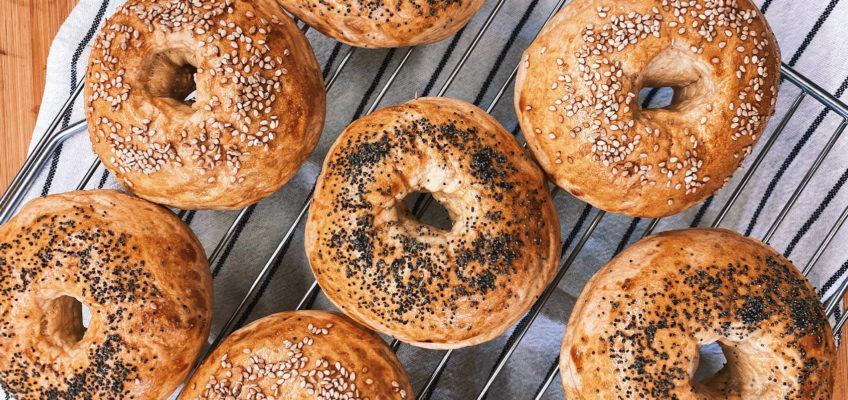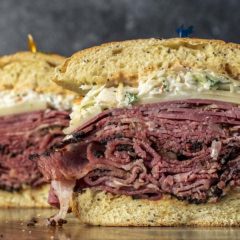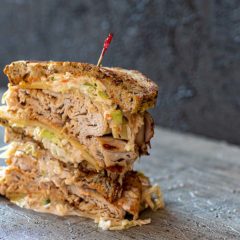When you think of New York City, a million things probably come to mind like architecture, pizza, an endless sea of yellow taxi cabs. But, there’s one thing special to every New Yorker’s heart – bagels. Despite not being invented in New York, it holds a special place in our culture, and stomachs as the go-to for morning bites. But, what’s the story behind the New York bagel? Why is it so popular in The Big Apple?
As one of Arizona’s most popular New York-Style delis, Chompie’s offers an array of deli favorites. Whether you are looking for kosher options or opting for a more traditional meal, we’ve got you covered. Read our blog post below to learn why bagels are a staple in NYC culture.
What Exactly are New York Style Bagels?
Before getting into the hows and whys, we need to look at what exactly a New York bagel is. According to the New York Times, “A New York bagel has a shiny crust with a little bit of hardness to it and a nice glaze. The inside is very chewy, but not overly doughy. It’s got a slight tang to the taste, and it’s not too big. But some people might disagree.”
A traditional bagel is made from wheat flour, salt, water, and yeast leavening. High gluten flour is preferred as they yield a firm, dense bagel shape and maintain a chewy texture. Additionally, most recipes call for a sweetener to be added to the dough.
According to 6sqft, bagels are made by:
- Mixing and kneading the ingredients to form the dough.
- Shaping the dough into the traditional bagel shape, round with a hole in the middle, from a long thin piece of dough.
- Proofing the bagels for at least 12 hours at low temperature (40–50 °F = 4.5–10 °C).
- Boiling each bagel in water that may contain additives such as lye, baking soda, barley malt syrup, or honey.
- Baking at between 175 °C and 315 °C (about 350–600 °F).
The Origins of New York Bagels
According to an article from The Atlantic, the history of the bagel can be traced back at least six centuries. Towards the end of the 14th century, Polish Queen Jadwiga ate ‘obwarzanek’, an early variation of the bagel, during Lent. Because of this, the bread became increasingly popular in Poland.
Another account contests this story, suggesting that the bagel dates back to 17th century Austria, where they were invented by a Viennese baker who paid tribute to Jan Sobieski, King of Poland, by baking bread in the shape of a horse stirrup. They called it a ‘beugel’.
Whatever one is actually true, the bagel went on to become linked with the Jewish religion in Poland, as it was one of the only places where Jews were allowed to bake and sell bread. Over the centuries, the bagel gradually became a part of the street food scene, making it readily available for the poor.
Once European Jewish immigrants began making their way to the United States, they brought many of their traditions and recipes with them. Gradually, those immigrants began spreading their culture and food in many parts of New York City. By 1900, there were 70 Jewish bakeries across the Lower East Side alone, and seven years later the International Beigel Baker’s Union was formed. Since then it’s only become bigger and more synonymous with the city.
No, It’s Not in the Water
You probably have heard that New York bagels are so good because it’s the water they use to boil them. America’s Test Kitchen put that to the test and found it’s actually a myth. While there was a different pH level and lower amounts of calcium carbonate and magnesium than in other cities, they found a very small difference between those made in New York and those that weren’t.
So, What Makes New York Bagels so Unique? Technique.
According to Vogue, it all really comes down to technique. Many bakers are unwilling to reveal the secrets to their recipe (why would they?), but one commonly-known aspect of the process involves cold-fermenting the dough. This process involves leaving the dough in the fridge for a number of days before rolling it out into its famous shape. The longer you leave the dough in the fridge, the tangier and crustier it gets.
Matthew Tilden of Scratch Bread Bakery told Vogue, “When you retard the dough, you’re just slowing everything down in a colder environment. What yeast thrives off of is lots of sugar and warmth. If you give them a different environment, they can only eat slower and yeast, typically, just really slows down in the cold. We’re slowing the process to develop better flavors, better crust, all that stuff.”
Chompie’s Makes the Best Bagels in Arizona
Since 1979, Chompie’s has been the restaurant of choice for Arizonians looking for a New York Style food that serves items like bagels, mile-high sandwiches, salads, and colossal Ruebens. We are proud of our long history of service and look forward to creating experiences you won’t forget. Visit one of our locations today and see why we’ve become one of Arizona’s favorite delis to date.













